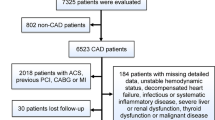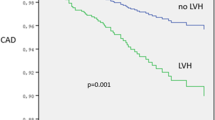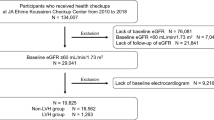Abstract
The aim of this study was to assess the contribution of increased concentrations of high-sensitivity C-reactive protein (hsCRP) and echocardiography to risk stratification according to the 2003 European guidelines for the management of arterial hypertension in patients with untreated hypertension. A total of 207 consecutive medical outpatients with untreated hypertension were included. History and clinical examination, electrocardiography, laboratory analyses including the measurement of hsCRP and echocardiography were performed in all patients. Patients were classified into four risk groups with and without using echocardiography and hsCRP concentrations of at least 10 mg/l according to the 2003 guidelines for the management of hypertension. The majority of the 207 patients (81%) were at moderate or high cardiovascular risk before adding echocardiography and/or hsCRP to the risk stratification process. When echocardiography was included, only three patients were reclassified from the moderate added risk to the high added risk group. Adding hsCRP concentrations of at least 10 mg/l had no impact on risk stratification. Using an hsCRP cutoff level of 3 mg/l, one patient was at moderate instead of low added risk, eight patients were at high instead of moderate added risk and one patient was at very high instead of high added risk. We conclude that hsCRP at the proposed cutoff level of 10 mg/l has no impact on risk stratification in outpatients with untreated hypertension. An hsCRP cutoff level of 3 mg/l may be more suitable for risk stratification. Finally, our data suggest that depending on the population studied, there is minimal impact of echocardiography on risk stratification.
This is a preview of subscription content, access via your institution
Access options
Subscribe to this journal
Receive 12 digital issues and online access to articles
$119.00 per year
only $9.92 per issue
Buy this article
- Purchase on Springer Link
- Instant access to full article PDF
Prices may be subject to local taxes which are calculated during checkout
Similar content being viewed by others
References
Ezzati M, Lopez AD, Rodgers A, Vander Hoorn S, Murray CJ . Selected major risk factors and global and regional burden of disease. Lancet 2002; 360: 1347–1360.
Collins R, Peto R, MacMahon S, Hebert P, Fiebach NH, Eberlein KA et al. Blood pressure, stroke, and coronary heart disease. Part 2, Short-term reductions in blood pressure: overview of randomised drug trials in their epidemiological context. Lancet 1990; 335: 827–838.
Gueyffier F, Boutitie F, Boissel JP, Pocock S, Coope J, Cutler J et al. Effect of antihypertensive drug treatment on cardiovascular outcomes in women and men. A meta-analysis of individual patient data from randomized, controlled trials. The INDANA Investigators. Ann Intern Med 1997; 126: 761–767.
Cullen P, Schulte H, Assmann G . The Munster Heart Study (PROCAM): total mortality in middle-aged men is increased at low total and LDL cholesterol concentrations in smokers but not in nonsmokers. Circulation 1997; 96: 2128–2136.
Anderson KM, Wilson PW, Odell PM, Kannel WB . An updated coronary risk profile. A statement for health professionals. Circulation 1991; 83: 356–362.
Conroy RM, Pyorala K, Fitzgerald AP, Sans S, Menotti A, De Backer G et al. Estimation of ten-year risk of fatal cardiovascular disease in Europe: the SCORE project. Eur Heart J 2003; 24: 987–1003.
1999 World Health Organization–International Society of Hypertension Guidelines for the Management of Hypertension. Guidelines Subcommittee. J Hypertens 1999; 17: 151–183.
2003 European Society of Hypertension–European Society of Cardiology guidelines for the management of arterial hypertension. J Hypertens 2003; 21: 1011–1053.
Schillaci G, de Simone G, Reboldi G, Porcellati C, Devereux RB, Verdecchia P . Change in cardiovascular risk profile by echocardiography in low- or medium-risk hypertension. J Hypertens 2002; 20: 1519–1525.
Cuspidi C, Michev L, Severgnini B, Meani S, Fusi V, Valerio C et al. Change in cardiovascular risk profile by echocardiography in medium-risk elderly hypertensives. J Hum Hypertens 2003; 17: 101–106.
Cuspidi C, Lonati L, Macca G, Sampieri L, Fusi V, Severgnini B et al. Cardiovascular risk stratification in hypertensive patients: impact of echocardiography and carotid ultrasonography. J Hypertens 2001; 19: 375–380.
Martinez MA, Sancho T, Armada E, Rubio JM, Anton JL, Torre A et al. Prevalence of left ventricular hypertrophy in patients with mild hypertension in primary care: impact of echocardiography on cardiovascular risk stratification. Am J Hypertens 2003; 16: 556–563.
Luque M, de Rivas B, Alvarez B, Garcia G, Fernandez C, Martell N . Influence of target organ lesion detection (assessment of microalbuminuria and echocardiogram) in cardiovascular risk stratification and treatment of untreated hypertensive patients. J Hum Hypertens 2006; 20: 187–192.
Ridker PM, Cushman M, Stampfer MJ, Tracy RP, Hennekens CH . Inflammation, aspirin, and the risk of cardiovascular disease in apparently healthy men. N Engl J Med 1997; 336: 973–979.
Ridker PM, Buring JE, Cook NR, Rifai N . C-reactive protein, the metabolic syndrome, and risk of incident cardiovascular events: an 8-year follow-up of 14 719 initially healthy American women. Circulation 2003; 107: 391–397.
Pearson TA, Mensah GA, Alexander RW, Anderson JL, Cannon III RO, Criqui M et al. Markers of inflammation and cardiovascular disease: application to clinical and public health practice: a statement for healthcare professionals from the Centers for Disease Control and Prevention and the American Heart Association. Circulation 2003; 107: 499–511.
Palmieri V, Dahlof B, DeQuattro V, Sharpe N, Bella JN, de Simone G et al. Reliability of echocardiographic assessment of left ventricular structure and function: the PRESERVE study. Prospective Randomized Study Evaluating Regression of Ventricular Enlargement. J Am Coll Cardiol 1999; 34: 1625–1632.
Devereux RB, Alonso DR, Lutas EM, Gottlieb GJ, Campo E, Sachs I et al. Echocardiographic assessment of left ventricular hypertrophy: comparison to necropsy findings. Am J Cardiol 1986; 57: 450–458.
Ridker PM, Cook N . Clinical usefulness of very high and very low levels of C-reactive protein across the full range of Framingham Risk Scores. Circulation 2004; 109: 1955–1959.
Stuveling EM, Bakker SJ, Hillege HL, Burgerhof JG, de Jong PE, Gans RO et al. C-reactive protein modifies the relationship between blood pressure and microalbuminuria. Hypertension 2004; 43: 791–796.
Ridker PM, Rifai N, Clearfield M, Downs JR, Weis SE, Miles JS et al. Measurement of C-reactive protein for the targeting of statin therapy in the primary prevention of acute coronary events. N Engl J Med 2001; 344: 1959–1965.
Conen D, Zeller A, Pfisterer M, Martina B . Usefulness of B-type natriuretic peptide and C-reactive protein in predicting the presence or absence of left ventricular hypertrophy in patients with systemic hypertension. Am J Cardiol 2006; 97: 249–252.
Leoncini G, Sacchi G, Ravera M, Viazzi F, Ratto E, Vettoretti S et al. Microalbuminuria is an integrated marker of subclinical organ damage in primary hypertension. J Hum Hypertens 2002; 16: 399–404.
Leoncini G, Sacchi G, Viazzi F, Ravera M, Parodi D, Ratto E et al. Microalbuminuria identifies overall cardiovascular risk in essential hypertension: an artificial neural network-based approach. J Hypertens 2002; 20: 1315–1321.
Tsioufis C, Dimitriadis K, Antoniadis D, Stefanadis C, Kallikazaros I . Inter-relationships of microalbuminuria with the other surrogates of the atherosclerotic cardiovascular disease in hypertensive subjects. Am J Hypertens 2004; 17: 470–476.
Ferrara LA, Vaccaro O, Cardoni O, Laurenzi M, Mancini M, Zanchetti A . Indexation criteria of ventricular mass and predictive role of blood pressure and body composition. Am J Hypertens 2005; 18: 1282–1287.
Wong ND, Pio J, Valencia R, Thakal G . Distribution of C-reactive protein and its relation to risk factors and coronary heart disease risk estimation in the National Health and Nutrition Examination Survey (NHANES) III. Prev Cardiol 2001; 4: 109–114.
Anand SS, Razak F, Yi Q, Davis B, Jacobs R, Vuksan V et al. C-reactive protein as a screening test for cardiovascular risk in a multiethnic population. Arterioscler Thromb Vasc Biol 2004; 24: 1509–1515.
Lakoski SG, Cushman M, Palmas W, Blumenthal R, D'Agostino Jr RB, Herrington DM . The relationship between blood pressure and C-reactive protein in the Multi-Ethnic Study of Atherosclerosis (MESA). J Am Coll Cardiol 2005; 46: 1869–1874.
Xie X, Liu K, Stamler J, Stamler R . Ethnic differences in electrocardiographic left ventricular hypertrophy in young and middle-aged employed American men. Am J Cardiol 1994; 73: 564–567.
Drazner MH, Dries DL, Peshock RM, Cooper RS, Klassen C, Kazi F et al. Left ventricular hypertrophy is more prevalent in blacks than whites in the general population: the Dallas Heart Study. Hypertension 2005; 46: 124–129.
Acknowledgements
This work was supported by unrestricted grant from Bayer Pharma, Zürich, Switzerland and from the University Hospital Basel, Switzerland.
Author information
Authors and Affiliations
Corresponding author
Additional information
Conflict of interest None.
Rights and permissions
About this article
Cite this article
Conen, D., Zeller, A., Dieterle, T. et al. C-reactive protein and echocardiography have little impact on risk stratification in never-treated hypertensive patients. J Hum Hypertens 20, 587–592 (2006). https://doi.org/10.1038/sj.jhh.1002048
Received:
Revised:
Accepted:
Published:
Issue Date:
DOI: https://doi.org/10.1038/sj.jhh.1002048



